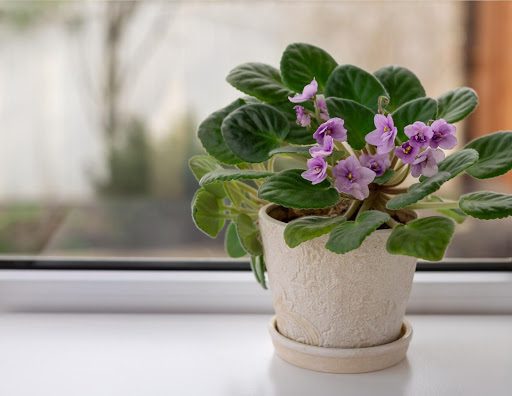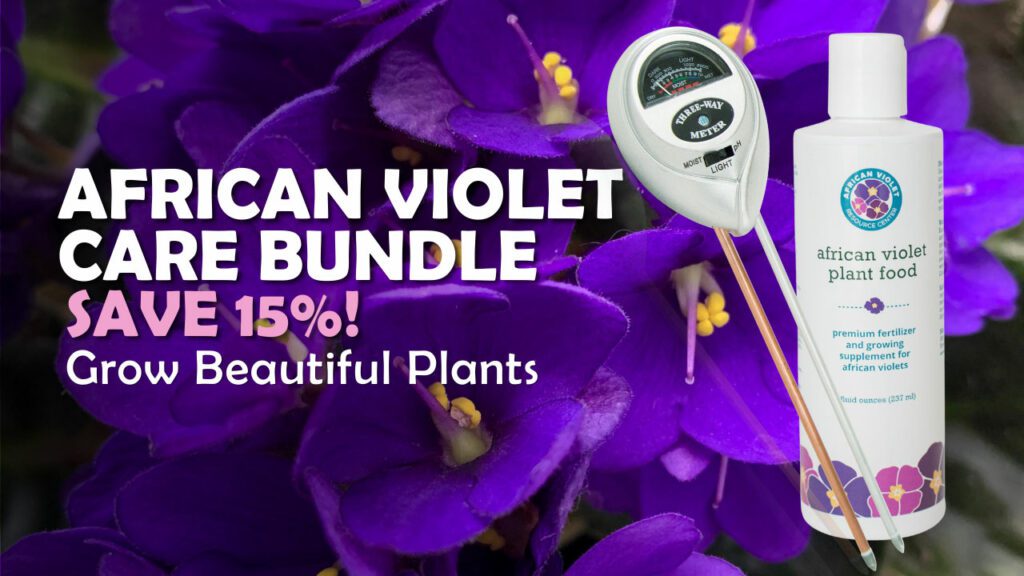Learn how much sunlight your African violet needs to thrive in your indoor garden.
You’ve done it. You’ve chosen the perfect addition to your indoor garden. It’s an African violet plant, and it’s perfect. With its unique, velvety foliage and its bountiful blooms, it’s fit to be your new favorite houseplant.
When you get home from the nursery, there are a few things to do. Namely, you’ll need to repot your plant, give it a good drink, start a fertilizer routine, and find the perfect spot for it to grow.
At first, you position it by a window, but you decide that spot’s a bit too sunny. Then you move your plant a few feet back and set it on your desk, but after a few days you’re afraid it won’t get enough light there. You consider a few alternative spots, but at the end of the day, you’re not really sure where your plant will do best.
Although getting started seems simple enough, finding the right spot for your African violet can be tricky. It should be positioned where it’ll have plenty of bright light, but very little direct sun since strong sunlight will burn your plant’s leaves and flowers.
Below, we cover the most important things to know about your African violet’s sun requirements so you can choose a spot for your plant that’s just right.
How much sun does my African violet need?
African violets thrive in indirect light conditions, and it’s important to keep in mind that too much direct sun will burn your African violet, stunt its growth, and prevent it from blooming.
During the hot afternoons of spring, summer, and fall, it’s best to provide filtered bright light by using shades or sheer curtains to shield your plant.
During the winter, your plant is more amenable to bright afternoon light, since winter light is less potent. Typically, it’s safe to stow your sheer curtains away until spring.
Professional Tip: It’s best to rotate your African violet a quarter-turn once a week to make sure it gets adequate sun on all sides. This is important to make sure your plant maintains even growth and a symmetrical rosette form.
What’s the best spot for indirect sunlight?
Since the sun is strongest during spring, summer, and fall, it’s safest to place your African violet in a north- or east-facing window to ensure the strong sun doesn’t burn it. Alternatively, you can move your plant a few feet back from the window and put it on a bookshelf or desk instead.
During winter months, African violets do well in south- or west-facing windows, positions that provide more light.
Professional Tip: When you’ve found the perfect spot for your African violet, be sure to use a growing mix that will promote good drainage. One of the most common causes of African violet death is root rot, which is brought on by dense traditional growing mix and over-watering.
Should I use a grow light?
African violets do well under grow lights, but the main risk factor when using them is light strength. For best results, mount your grow light at least a foot above your plant. To check that the light isn’t too hot, place your hand below the light. If your hand warms, move your light higher.
Professional Tip: If you opt to use a grow light, be sure to purchase a light that includes both blue and red light spectrums. These are the rays your plant needs to thrive.
Does my African violet need light all the time?
Nope! In fact, periods of darkness are just as important to your African violet as periods of bright indirect light. Darkness promotes blooms in African violets, so it’s crucial to make sure your plant gets some reprieve from sunlight and grow lights.
Professional Tip: For long-lasting, healthy blooms, provide your plant with at least 12 hours of sunlight and at least 8 hours of nighttime darkness.
How do I know if my African violet is not getting enough sun?
If your African violet isn’t getting enough sun, it’ll let you know. Keep an eye out for yellowing leaves, leggy stems, and stunted bloom growth, the telltale signs that your plant is undernourished and needs more sun to stimulate healthy photosynthesis processes.
Professional Tip: If your plant isn’t getting enough sun, don’t try to overcompensate by placing it in direct sunlight. Instead, choose a slightly brighter position and gradually move your plant closer to a light source to prevent plant shock and overwhelm.
How do I know if my African violet is getting too much sun?
If your African violet is getting too much sun, it’ll start showing signs on its leaves and blooms, which typically present as brown spots, curling leaves, and fading blooms.
Professional Tip: If your African violet starts developing sunspots, move it out of the direct sun immediately. Scorched leaves will eventually repair themselves, though the damage will spread quickly if the plant is left exposed to strong sun.
A Recap: African Violet Light Requirements
Choosing the perfect spot for your African violet might feel a bit tricky, but it’s important to know that your African violet’s sun needs are quite simple.
Here’s a recap of best practices to find the perfect spot for your plant:
- Place your African violet in indirect sunlight since direct sun will easily burn your plant.
- During spring, summer, and fall months, the sun is strongest. Move your plant to a north- or east-facing window during these months.
- If you use a grow light, be sure to use one with both red and blue light spectrums.
- Provide your African violet with natural light and dark cycles to encourage bloom and keep your plant healthy.
- Be on the lookout for the telltale signs of too little sun: yellowing leaves, leggy stems, and stunted bloom growth.
- Be on the lookout for the telltale signs of too much sun: brown spots, curling leaves, and fading blooms.
For best results, use a gentle liquid fertilizer designed for your African violet. Our African Violet Plant Food is made with humic-fulvic acid and sea kelp extract to boost nutrient uptake and encourage hearty roots and vibrant blooms. It’s gentle enough to use every time you water and won’t burn your plant’s delicate root system. Simply add a teaspoon of fertilizer to your normal plant routine. Then sit back and enjoy your plant as it blooms month after month.
For continued success, explore our other articles, visit our online shop, and connect with other African violet plant lovers in our Facebook group. There, you’ll find everything you need to know to grow your African violet big and strong so you can enjoy it for a long, long time.







